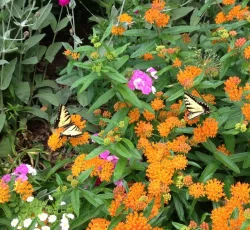
Adam's Needle
Yucca filamentosa
This unique plant looks more suited to a desert climate, but it is found wild up and down the east coast. Its strappy leaves are crowned by huge spikes of creamy white flowers every other year.
EXPLORE THIS PLANT
This unique plant looks more suited to a desert climate, but it is found wild up and down the east coast. Its strappy leaves are crowned by huge spikes of creamy white flowers every other year.
EXPLORE THIS PLANT
This plant is used as a perennial fodder crop for livestock.
EXPLORE THIS PLANT
Asparagus is an unusual plant that is primarily cultivated for its edible tender young shoots in the spring. When mature, it has large ferny foliage that is pale green.
EXPLORE THIS PLANT
Bee Balm is a tall summer-blooming perennial with brilliant red flowers subtended by a whorl of showy, red-tinged, leafy bracts. The aromatic leaves can be used for tea, but are susceptible to mildew, so this plant needs good air circulation. A member of the mint family, bee balm spreads readily by rhizomes and self-seeding to form large colonies, so be prepared to divide it every few years.
EXPLORE THIS PLANT
A cottage garden favorite, black-eyed susan features masses of ferociously yellow flowers that attract butterflies. They are incredibly hardy and tolerate a wide variety of conditions, making them ideal for naturalizing.
EXPLORE THIS PLANT
Blackberry lilies are named for their glossy black seeds which look nearly identical to an actual blackberry. They have beautiful orange flowers with darker spots on long graceful stems above strappy green foliage.
EXPLORE THIS PLANT
This unique plant features bright blue-purple flowers on tall green stalks followed by interesting black seedpods. It forms a deep taproot and does not transplant well, so be certain of its location before planting.
EXPLORE THIS PLANT
Brown-eyed Susans form masses of bright gold flowers above dark green foliage. It will flop without a midseason trim to keep it from getting too tall. It is ideal for naturalizing because it reseeds readily.
EXPLORE THIS PLANT
This plant features brilliant orange flowers that light up the garden and are attractive to pollinators, including monarchs and honeybees.
EXPLORE THIS PLANT
This compact plant is covered in drifts of tiny white flowers in the spring. It blooms at the same time as many of the spring bulbs and provides a nice accent among them.
EXPLORE THIS PLANT